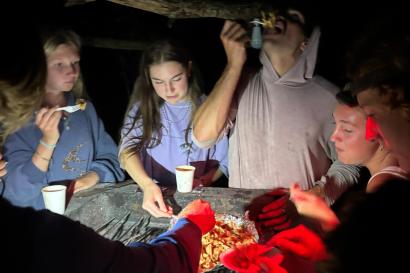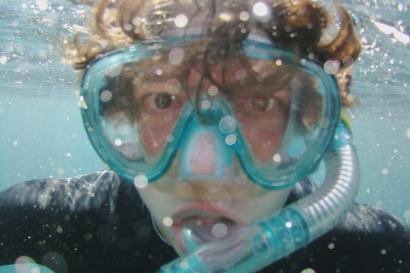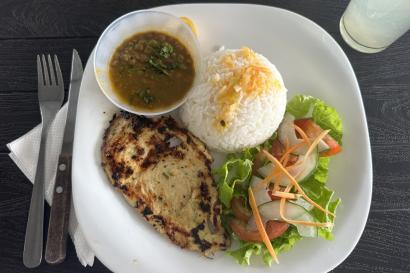After a week of not showering and $10/night hostels in the depths of Argentina's south I was about to be shocked by the amount of pampering and pre-planned activities in the north of Argentina. A mere 4 days after our spring break trip into the wilderness, 9 other students and I were heading to Salta and Jujuy - 2 northern provinces of Argentina - and the real kicker? The whole 5-day excursion was planned in full. This trip would be hotels and real meals instead of campgrounds and undercooked sausage. While I missed the sense of accomplishment and doing things on my own terms, the planned trip to the north had some unexpected benefits. Here is the story of northern Argentina; the good, the people, and the different.
Our journey to Salta began with a plane ride. Funny how much time it saves when you don't take the bus. There was also someone at the airport awaiting our arrival which honestly came as a shock after our scrambles to find transportation and directions to hostels on our past excursions. Walter, our bus driver, became the MVP of the trip :)
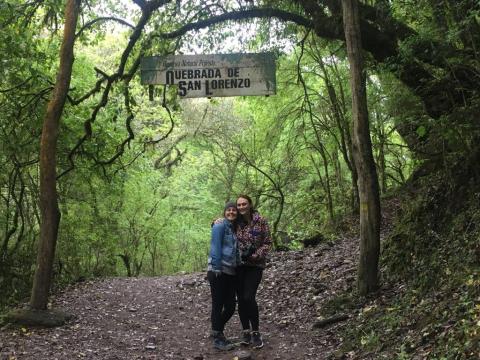
Our first stop was San Lorenzo, a micro-climate within the province of Salta. As we drove along through dry air and light-colored mountains you could see a cloud hovering in the distance. Beneath the cloud was San Lorenzo, a tiny rainforest chilling right in the middle of the desert-esque province. This was our first impression of Salta, wet and slippery (I only fell once on our little trek ;)) so we were unprepared for what was to come.
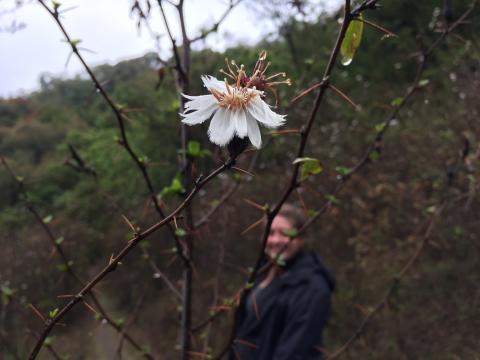
The only dewey part of a dry region, feat. Em
It was on this trek that we also learned about Pachamama, or La Madre Tierra (Earth Mother in English). People build stone piles to represent the Pachamama and give offerings to her such as alcohol or coca leaves. She is an important spiritual figure especially within the northern region and we got to offer her coca on our trek. While making offerings to Pachamama is a regular habit for many, there are yearly celebrations within families to make larger offerings as well! If you're ever thinking about making an offering, always use two hands ;)
After our adventures in the rainforest we had a guided tour through the center of Salta and MAAM, the Museo de Arqueolía Alta Montaña (High Altitude Museum). Sounds boring but this wasn't your typical museum. The museum displayed the bodies of young children that had been sacrificed as part of an Incan religious tradition. Because of the altitude, the bodies are in near perfect condition.
What was especially interesting about MAAM was the controversy surrounding the museum and the extraction of these children to be put on display. Should archaeologists be able to do these extractions without the permission of these communities? Now there are laws about gaining permission before excavations, but the museum's presence still remains controversial. We weren't even allowed to take pictures on the premisis, sorry to disappoint.
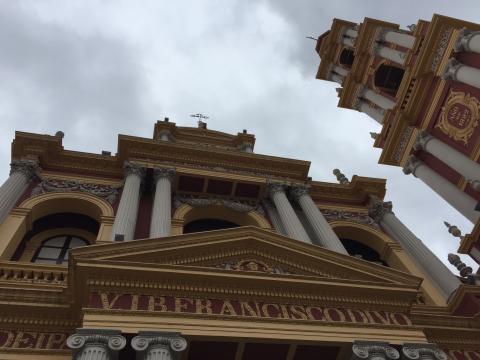
This is the church of San Francisco. While it is not the official cathedral of Salta, it holds the tallest bell tower (campanario) in South America!
The city of Salta was much more alive than any part of the south we had been to. The city center was apparently home base for all city activities, and the square was full when we arrived. According to our guide, Salta has one of only three remaining cabildos in Argentina. Another exists in Buenos Aires but the one in Salta is much bigger :)

View from one of the many terraces near the Cabildo
Our second day we were already leaving Salta for Jujuy. Thanks to the connections of our travel agent Jaime (bougee, I know) we had lunch at Solar del Trópico, a humble abode isolated in the mountains that is home to the artist Remy. There were horses, incredible food, and so much green!!

The humble abode aka my dream home. We were literally in heaven at this place - and everything was run by solar power even the showers :)
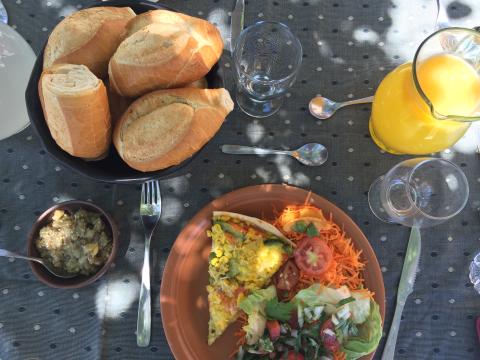
This was the first part of our meal, little did we know there would be a whole other course... we thanked Pachamama (Earth Mother) for her wonderful offering :)
The food from this northern region was all so fresh. While each town had its own agricultural specialties, most of the grains, veggies, and starches we ate on the trip were grown in the region!
Since Remy was away on a trip, a fellow artist, Itamar, showed us around his workshop and talked to us about his art and its relationship with the north. Remy uses a ton of found objects as a way of paying tribute to la Madre Tierra. All over the floor were shells, dried cacti, and old wood...
Itamar explained his life story too: how he ended up in the north and why he never left. While his wife and him were debating on moving to the South vs. to Mendoza, they landed on the north as a compromise (classic). When they tried to move later on in their lives, they missed it too much and decided to come back. He explained that the north has an unstoppable duo: beautiful nature and culture, that you can't get anywhere else. You don't have to settle for landscapes or tradition, you get it all!
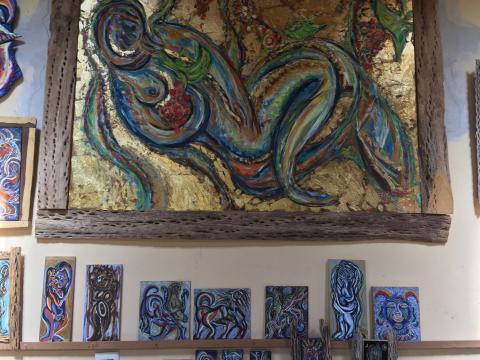
Some of Remy's art - he was in France while we were there but we took a peak at his works anyways
Our guide, Leila also told us about her experience in the region of Tilcara. According to Leila and Itamar, the north never sleeps. The people jump from festivity to festivity and never stop. El Diablo (devil) is an important figure in these celebrations and there are festivals surrounding his presence. As we drove in, you could see statues of the devil... interesting and yet a huge part of the northern culture. Many people dress up as Diablos during annual festivals (including Leila's mom and brothers) and people kill to dance with them. She warned us that you have to check out the hands of the Diablo to know who you are truly dancing with and some people are more picky than others... ;)
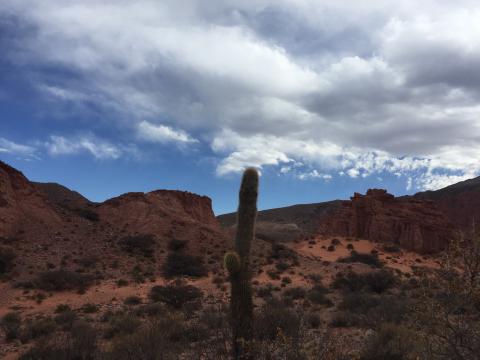
After leaving the Remy's oasis, we headed on our daily trek. Leila led us La Quebrada de Las Tres Señoritas, and told us the myth of the three women that ran away to these areas to escape persecution. Another benefit to having these wonderful guides was hearing these local tales. Leila grew up in this area with these myths and we got to look at a mountain and find a bonus story within it.
Our third day we headed out early for the salt flats but were stopped early because a bus had tipped on the thin mountain pass. Silver lining: we got to walk and enjoy the scenery even more on our way to Purmamarca.
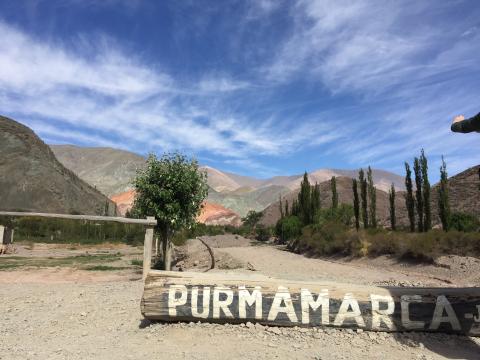
Peep the woman's arm that wouldn't get out of the way, but the view is still incredible!
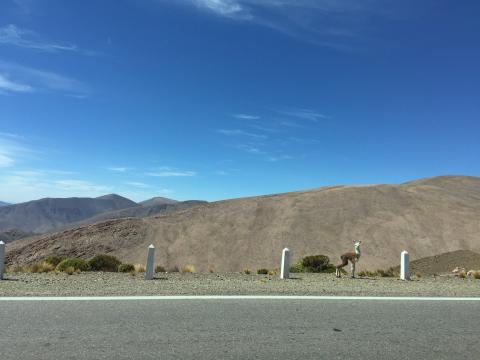
Baby llama siting on the way to the salt flats!
The road to the salt flats was beautiful and nauseating all at once. We got up to crazy high altitudes and many of us started feeling sick. The solution? Chewing coca leaves. Coca is the base, and natural form, of cocaine and especially within these high-altitude regions it is incredibly helpful in reducing nausea and even surpressing your appetite. You put these leaves in the side of your cheek and it gives you energy to stay awake wayyyy up. While the leaves are controversial in some countries because of their connection to cocaine, they are widely used in the north of Argentina and many parts of Peru!
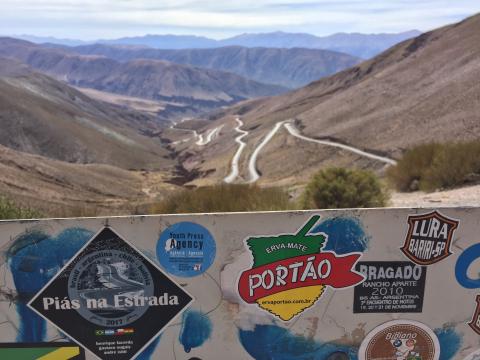
We stopped along the mountain pass... we started from the bottom and from here we were still far from the top!
As we descended this crazy height and finally started to feel less nauseus, we came across the Salinas Grandes! (huge salt flats). While there are larger salt flats in Southern Bolivia and other parts of South America, Jujuy's Salinas Grandes are formed from volcanic ash. Another perk to traveling with this group? We got special access to the depths of the flats and got to share lunch with Ariel and his family that have been working on the flats for years :)
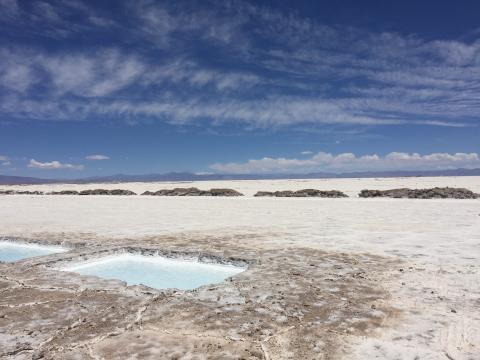
The vastness that was Las Salinas - the hectagonal ridges on the ground are the equivalent of puddles formed in the salt
Ariel works in Las Salinas Grandes extracting salt just as his father and his grandfather did before him. Him and his family invited us for lunch, locally grown potatoes and homemade tartas, on the flats. One girl on our trip found a worm in her potato which goes to show how organic the whole experience really was ;) We got to learn about the process of salt extraction, the new techniques that Ariel's family developed, the tales of the evil eyes on the flats, and we even got to stick our feet in the water that had accumulated on the sites.
The giant holes of water are where the salt had been extracted. The salt grows back in these sites after only a year and then is ready to be extracted from the same spot again. Beneath this minimal layer are many other layers as well: agua dulce (which is spring water in Spanish), more layers of earth, and all the way beneath was the original lagoon that the flats formed upon. Throughout the years, Ariel's family created the most efficient tools and found the most best size to extract the salt. You'll notice that there are holes of different sizes on the flats - these areas are owned by different families with different techniques.
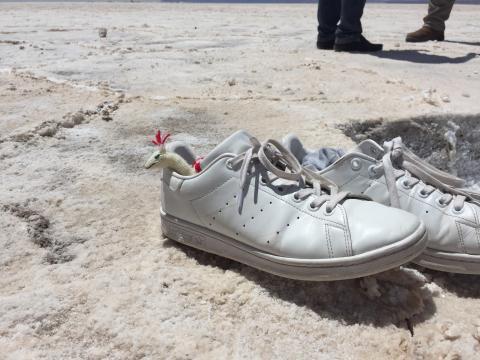
The bottom of the excavation sites were sharp and salty but we stuck our feet in for a nice massage anyways. The flats were so much more vast than I expected and thanks to Jaime once again, we were in the middle of them all alone.
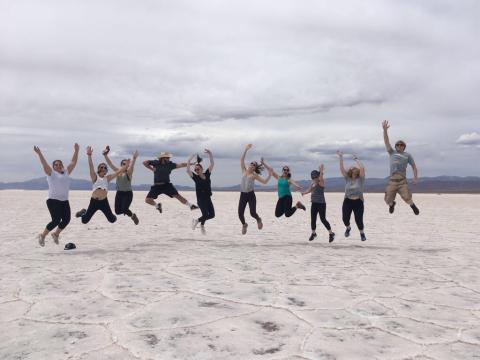
Us and the vastness that was the flats! This was also the day that we all got burnt to a crisp :) You could see everyone's outfits from the day before just in the sunburns we extracted :P
Our afternoon consisted of a trek where we learned about the colors of the mountains. El Cerro de Siete Colores (Peak of Seven Colors) is just one of the many mountains that resembles a tie-dye Fruit Rollup. Each layer of the mountain represents a different age of the mountain's life, like rings inside a tree. As the tectonic plates shifted and pushed the layers into the formation it holds today, the colored layers became visible!
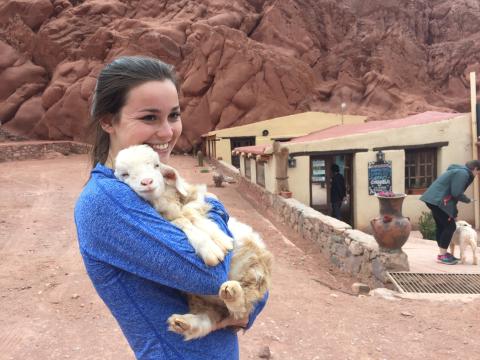
After our stroll we stopped for snacks, coca tea, and baby goat lovin :) Meet Gracie, snuggling the cutest little thing
Our next day was a combination of silly and exciting. While there were definitely perks to going on this trip with IES Abroad as far as interactions with local people and amazing food, parts of the trip were far beyond what I would consider "normal." Day four we woke up to explore a market. Sounds normal right? We walked past the feria (many would consider this a market) and on to the indoor mercado. The place was full of local produce, used clothing, games, and really anything you could imagine.
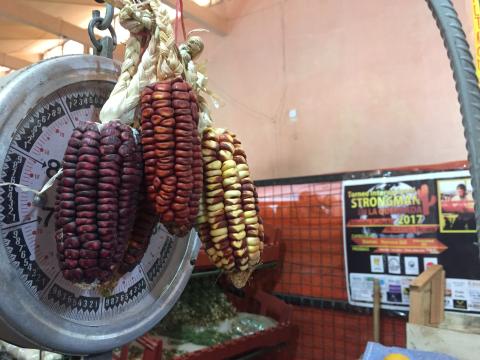
Quinoa in the northern mercados is dirt cheap because agriculture is their game :)
None of this seemed out of the ordinary until we got back to our hotel and there were hoards of llamas waiting for us to arrive. Not something you see every day ;) If we didn't feel touristy before that, having people stare at us as we walked down the street llamas in hand was definitely doing that for us. They were literally on leashes... While I wasn't exactly sure the purpose of walking the llamas, I had the best conversation with Adela who was leading the pack.
Adela used to live in Buenos Aires, in fact she cooked for the Pope before he became the Pope!! She told me about how she came to the north when she needed a break from the city and realized that she loved the llamas and that her quality of life was much better there. She said she still likes to cook and she misses her kids (who still live in the city) but they come to visit her every year for the holidays! She told me she doesn't get to see the Pope much though, now that he is famous and all, because he is much busier (I laughed but she was dead serious). This wonderful woman made us yet another ~fresh~ lunch and gave me a confidence boost on my Spanish simultaneously ;)

View from our gorgeous walk along the edge of Tilcara - not sure I needed Jacobo (my llama) in order to be content but they definitely were funny creatures

Llamas are the domesticated version of Guanaco. This little guy was either not hungry or was just looking for a photo shoot ;)
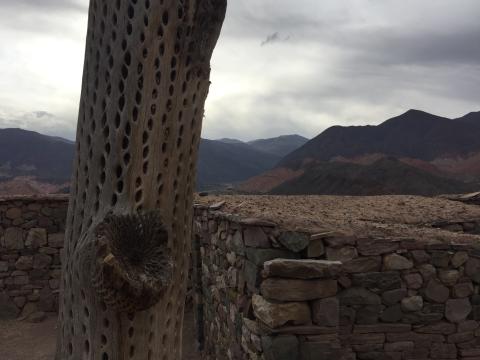
This is what dry cactus looks like!
We took a long nap before our last stop: Pucará. Pucará was a partially reconstructed Incan ruin that sat atop a hill on the edge of Tilcara. When the rest of the city was overlaid by a giant land slide and had to be rebuilt, Pucará was all that remained. While much of it was rebuilt to mimick the original structure, it is obvious which parts and foundations still exist from the original town.
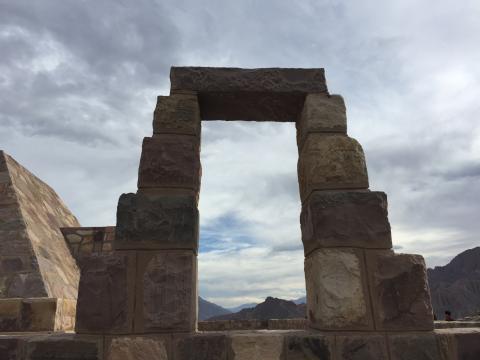
The coolest part about Pucará was Fabricio's (our guide's) representation of it. As we approached the temple, he walked us to a plaque where a bunch of tourists were taking pictures. He stopped the tourists and used them as an example for everything that was wrong with the plaque's inscription. After the ruin's original discovery, the history of this town was declared dead and forgotten. Fabricio pointed to these tourists and asked them where they were from, the north they responded. He pointed out their skin color, their eye shape, their children, and their storytelling... how could you stand by this temple and say your history is dead, he asked them.
While the plaque claimed that this place and these people were forgotten, Fabricio insisted that they lived on. The culture and the tradition of this place, as with most of the north, lives on in the people. Himself, this family, and many of the other people we had encountered carry on these traditions and the history of these places through their stories and their rituals. Without trying to be offensive he told this family that they should contemplate their history and the resiliance of these northern cultures, and not take pictures in front of monuments that talked about it otherwise. While the encounter was slightly awkward in the moment, it was something I never would have considered otherwise, not without Fabricio's insights.

After a long day (and the long days before that) we relaxed with a nice face mask :)
Our last day was going to test my mind as well. Our first stop was a school in Chorrillos, not too far from Tilcara. When we arrived I was feeling all kinds of ways: uncomfortable, awkward, unsure. While the experience of interacting with local people was a huge and enriching part of our adventure, at some times it felt invasive. I'd like to think we were gracious and making the most of these kind and welcoming people, yet it still felt like a spectacle or an invasion of space at some points.
Despite my hesitations and somewhat guilty feelings, I can say for sure that our group and the kids at the school had a blast together. We sang the 'eensy-weensy' spider in Spanish and they performed the Three Little Pigs for us. We epically failed at trying to teach numbers in English but definitely killed the piggy back ride races :) My favorite was little Nacho, who I later found out had skipped kindergarten because his mom was the teacher and he just didn't want to go :P
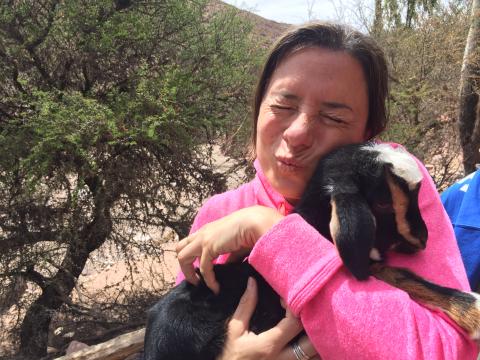
Flor, our most amazing chaperone, and our baby goat friend :)
After visiting the school, a former student, Gabby took us to her house for lunch and to spend time with her family. Gabby, her siblings, and her parents, Hector and Clarita, lived on a tiny farm that hosted tourists for work. You could come visit the family for a meal, for a day, or for a year and they were generous enough to host us with giggles (mostly Clarita ;)) and amazing food!
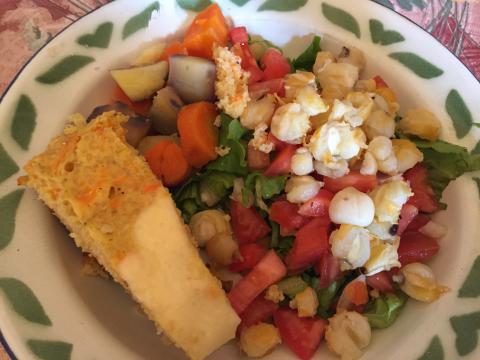
Fresh lunch with some fresh people :)
Gabby showed us the 6-week old goats and we all shared a lunch of veggies and goat meat, courtesy of Hector. Had I known it was goat meat before I may not have eaten it, but 10/10 recommend, it was delicious! After lunch, Clarita invited us to help her make bread and showed us how to create shapes of llamas and other animals like the family does for special celebrations! Clarita's family was the best ending we could've asked for, none of us wanted to leave and yet we were all so wiped. We waited until the bread came out of the oven before we left of course ;)
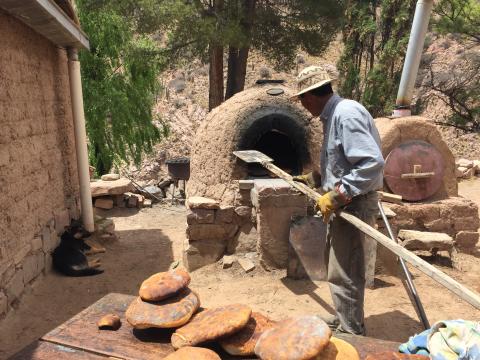
El jefe, Hector, working the grill
Two weeks after the experience I think I am still processing its effects. Not only was it wildly different to not have to plan anything at all for this trip, but the North itself was wildly different than the South. While during the trip I was off-put by the lack of independence and not having that sense of accomplishment, I know there is so much that we did that I never would've been able to do by myself.
My host sister told me before I left that I shouldn't go with the IES Abroad group; she said that I would be spending a ton of time hopping on and off busses to see touristy destinations and that it wouldn't be enough time to explore all that the north had to offer. Was she right? We did hop on and off busses and of course I would've stayed for much longer. Each little town had its own thing, its own people, its own food and culture and twang. And yet, she was wrong as well. I got to chat with Adela about her past life, and stroll through Tilcara with Gracie. I got to watch videos of Leila's family dancing and hear the life story of a local artist. It would never be "enough" and yet it was so much more than I imagined going in.
Talking with other students, I could tell that our trip was wildly different. Did it feel touristy at times? Yes. Were they right in saying that we wouldn't be able to have this experience otherwise? Definitely.
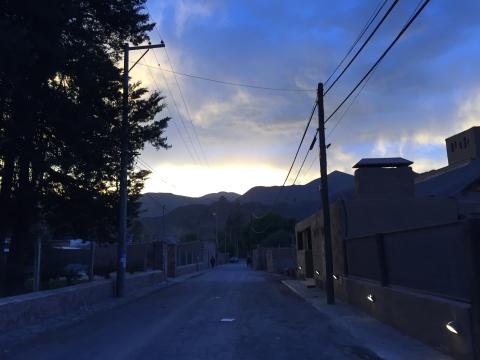
Views from a stroll through Tilcara
Maybe one day I'll go back and bop from town to town on my own volition like my host sister recommended, but after this trip I can say for sure that I will have people to bother there when I do :)
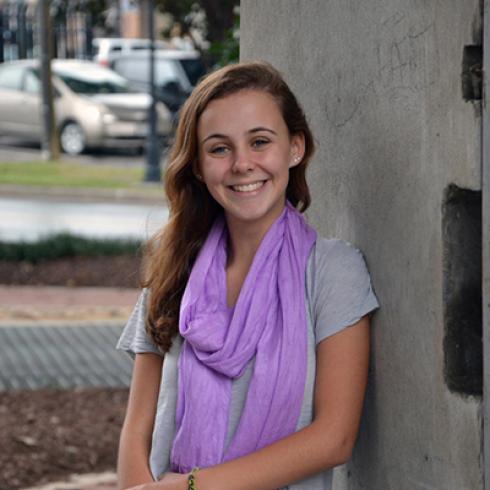
Jessica Duska
<p>I am just your average dog-loving, cheese-obsessed girl going into my last year as an undergrad.</p>





